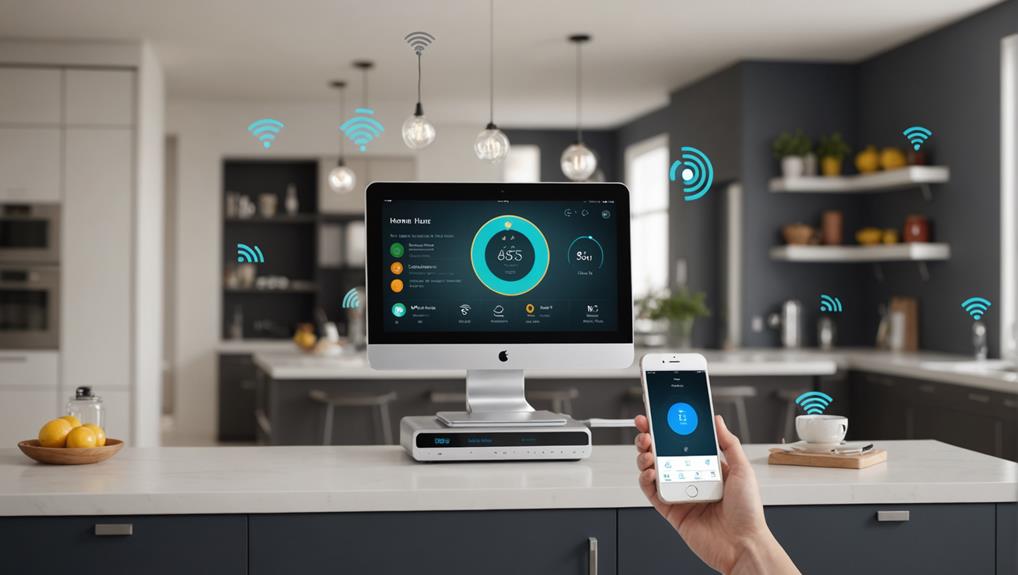Integrating alarms with smart home devices enhances security and convenience. Confirm seamless operation by connecting systems to platforms like Amazon Alexa and Google Home. Utilize Z-Wave, Zigbee, or Wi-Fi for essential communication compatibility. Regularly updating firmware maintains security features. Backup systems with reliable connectivity and battery support guarantee round-the-clock protection. Customize alerts with sensors and smart locks, and automate lights and cameras for added safety. Explore community-built integrations for tailored solutions and extended functionality. Cloud services offer remote access and real-time monitoring for enhanced security. Upgrade your system for improved integration and functionality.
Key Takeaways
- Ensure alarm system compatibility with Z-Wave, Zigbee, or Wi-Fi for integration.
- Update firmware regularly to maintain compatibility and security features.
- Utilize platforms like Amazon Alexa or Google Home for voice control integration.
- Consider devices supporting the Matter standard for future-proofing.
- Follow expert guides for seamless integration tips and smart home security.
Smart Device Compatibility Considerations

When considering smart device compatibility for integrating alarms with your smart home devices, guaranteeing seamless operation and communication is vital.
Smart home integration relies on the connection between your alarm system and other smart devices to enhance security and convenience in your home. By connecting alarms to smart devices like locks, cameras, and lights, you can receive real-time alerts and automate responses to potential security threats.
Many smart alarm systems offer integration with popular platforms such as Amazon Alexa and Google Home, allowing for voice control and automation capabilities. For a more thorough setup, you can refer to essential tips from experts on smart home security.
To guarantee the smooth functioning of your smart security systems, it's imperative to select devices that communicate over the same network protocols, like Z-Wave or Zigbee.
This compatibility guarantees that your alarms and smart devices can work together effectively to protect your home. Additionally, regular firmware updates for both your alarm system and smart devices are vital to maintain compatibility and enhance security features over time.
Wireless Signal Reliability Assessment

Evaluating the strength of wireless signals in your smart home security system is essential for ensuring reliable connectivity.
Wireless systems offer flexibility and ease of installation, but they might face signal interference or range limitations.
By evaluating the connectivity and testing the reliability of your alarms, you can identify potential weak points that may compromise your system's effectiveness.
Understanding these results will help you make informed decisions to enhance the security of your smart home devices.
Signal Strength Analysis
To evaluate the reliability of wireless signals in smart home alarm systems, a thorough analysis of signal strength is essential. Signal strength analysis is vital for ensuring that your smart home security system operates effectively and provides the protection you need. Below is a table highlighting key aspects to take into account when evaluating signal strength in your smart home security setup:
| Signal Strength Analysis |
|---|
| Evaluate Coverage in Environments with Interference |
| Contemplate Potential Jamming Threats |
| Opt for Hardwiring Sensors for Enhanced Reliability |
| Address Security Gaps Caused by Weak Signals |
| Conduct Regular Evaluations for Consistent Performance |
Connectivity Evaluation
For a thorough evaluation of your smart home alarm system's reliability, evaluating the connectivity of wireless signals is essential. The materials in your home, such as steel and concrete, can impact the strength of wireless signals, potentially causing interference and affecting performance.
It's vital to assess wireless coverage in challenging environments to guarantee that alarm sensors can effectively communicate with the central hub, maintaining reliable connections. Additionally, burglars may use jammers to disrupt wireless security systems, underscoring the significance of robust signal strength and system reliability.
To enhance the dependability of your alarm system, consider hardwiring sensors, especially in places with difficult wireless conditions. Regularly checking the wireless signal strength and connectivity can help pinpoint any weaknesses in the communication network of your alarm system, ensuring maximum functionality and security for your smart home.
Reliability Testing Results
Evaluating the reliability of wireless signals in smart home alarm systems is essential for ensuring ideal performance and security. Signal interference from steel and concrete structures can compromise effectiveness, emphasizing the need for robust connectivity evaluations during installation.
Burglars exploiting jammers to disable wireless security systems underscore vulnerabilities in wireless communication that must be addressed.
To enhance reliability, consider hardwiring sensors as a solution to prevent issues associated with wireless signal loss. Additionally, examining wireless coverage and signal strength during installation is critical for ensuring consistent connectivity, especially in challenging environments.
For peak security, prioritize UL listed security systems with backup batteries providing at least 12 hours of operational capability during power outages. This feature is vital for maintaining alert notifications and ensuring continuous monitoring even in adverse conditions.
Backup System Planning for Outages

Guaranteeing continuity of security measures during power outages is vital for maintaining the effectiveness of smart home alarm systems. Backup systems play an important role in this regard. UL listed systems mandate at least 12 hours of battery backup to guarantee alerts and operations continue seamlessly.
When considering costs, it's important to factor in initial setup and equipment expenses. Smart home security systems like Ring use cellular notifications to provide alerts even when internet connectivity is lost, enhancing reliability during outages.
Consider personal battery backups to supplement your smart system for receiving critical alerts during power failures. Regular maintenance and testing of backup batteries prevent failures during emergencies, guaranteeing functionality when most needed.
When planning for outages, opt for systems supporting dual path communication for seamless changeover between internet and cellular connections, guaranteeing constant monitoring.
Customization for Specific Security Needs

Tailoring your smart home security system to meet your specific needs is essential for maximizing its effectiveness. Customizable sensors allow you to fine-tune alerts and monitoring, guaranteeing you receive only relevant notifications.
Smart locks offer the flexibility to program unique entry codes for different family members, enhancing security by tracking individual movements. Setting up automation features to activate smart lights and cameras upon detecting motion provides immediate visibility and response to potential threats. Leveraging advanced monitoring systems can further enhance the accuracy and reliability of your alerts, assuring that you're always informed of any unusual activities.
Integrating smart doorbell cameras with alarm systems not only enhances monitoring at entry points but also enables remote communication with visitors for increased control.
Additionally, creating personalized automation routines that adjust security settings based on your daily schedule, such as arming the system when leaving home or activating lights at night, can further enhance the security of your home.
Leveraging Community-Built Integrations

You can tap into a wealth of benefits by leveraging community-built integrations for your smart home devices.
These collaborative solutions offer a way to enhance alarm connectivity and create tailored smart solutions that meet your specific security needs. By accessing community-developed apps and scripts, you open up opportunities for expanding your system's capabilities beyond what official integrations may offer.
Additionally, integrating Internet of Things (IoT) devices with your home security system allows for improved home protection, enabling real-time monitoring and automated responses to potential threats.
Community Integration Benefits
Leveraging community-built integrations can greatly enhance the functionality and versatility of your smart home devices when integrating alarm systems. By tapping into the collective expertise of the community, you can access a world of possibilities for customizing your home automation setup. Here's a glimpse of the benefits you can enjoy:
| Benefits of Community Integration |
|---|
| Expanded Functionality |
| Customized Automations |
| Enhanced Device Interoperability |
| Improved User Control |
| Collaborative Troubleshooting |
Through community integrations like IFTTT, you can go beyond standard features and tailor your smart home experience to suit your unique needs. These integrations empower you to create personalized automations triggered by your alarm system, offering a level of control that goes beyond pre-set options. Additionally, engaging with the community allows you to troubleshoot issues effectively and optimize your setup, ensuring your home security is exceptional. Embrace the collaborative spirit of community-driven projects to discover innovative solutions that elevate the efficiency of your smart home and alarm systems.
Collaborative Smart Solutions
With community-built integrations, enhancing the functionality of your smart home devices through customized automation becomes a seamless process.
Leveraging these collaborative smart solutions allows you to go beyond the limitations of standard integrations. While official security systems may not fully sync with SmartThings, community-built solutions enable you to connect a variety of devices for more extensive home automation.
IFTTT offers a user-friendly platform to create conditional commands and workflows based on specific triggers, enhancing the connectivity between your devices. Additionally, Alexa routines provide an intermediary option for limited integrations, especially with devices like Ring systems, facilitating automated responses to security events.
Looking ahead, advancements like the Matter protocol hold promise for increased compatibility and integration options among your smart home devices.
Enhanced Alarm Connectivity
To enhance alarm connectivity through community-built integrations, users can explore innovative solutions that expand the functionality of their smart home devices beyond traditional boundaries. Here are three key strategies to contemplate:
1. Explore IFTTT Integration: By utilizing IFTTT (If This Then That), users can establish connections between their alarms and other smart devices, enabling automated responses based on specific triggers.
While these integrations may not be officially supported by manufacturers, they can enhance the overall functionality of the smart home ecosystem.
2. Leverage Alexa Routines: Although no official security system fully integrates with SmartThings, users can leverage Alexa routines to create basic interactions between alarm systems and smart devices, especially with Ring products.
This workaround allows for some level of integration and control within the smart home setup.
3. Contemplate Multiple Hub Setups: Some users have reported success in creating independent setups using multiple hubs to enhance control and connectivity between alarms and various smart home devices.
This approach showcases the importance of customization in integration efforts, offering a tailored solution to meet specific needs.
Cloud Services for Enhanced Functionality

Cloud services play an essential role in enhancing the functionality of alarm systems integrated with smart home devices. These services enable remote access and control of your alarm system, allowing you to monitor and manage security devices from anywhere through dedicated apps.
As smart security systems continue to evolve, the capability to receive real-time alerts and updates on your smartphone or other devices becomes increasingly crucial. By utilizing platforms like IFTTT, you can create custom automation and interactions between your alarm system and other smart home devices, ultimately improving overall functionality.
Integrations with third-party services like Amazon Alexa also offer voice command capabilities for convenient arming and disarming of alarms. It's significant to acknowledge that smart home devices relying on cloud services require a stable internet connection for notifications and remote functionalities.
Looking ahead, advancements like Matter may enhance local communication between alarm systems and smart home devices, potentially reducing reliance on cloud services for improved performance. Make sure to take these factors into account when integrating alarms with your smart home devices for a seamless experience.
Evaluating Protocols and Platforms

As you evaluate protocols and platforms for integrating alarms with smart home devices, consider the compatibility of alarm systems with existing smart home protocols like Z-Wave, Zigbee, or Wi-Fi.
With the future of smart home security systems rapidly evolving, it's crucial to choose systems that can adapt to new technologies.
To make an informed decision, keep the following points in mind:
- Compatibility is Key: Verify that the alarm system you choose works seamlessly with popular smart home protocols such as Z-Wave, Zigbee, or Wi-Fi for smooth communication between devices.
- Future-Proofing: Look into devices that may support the upcoming Matter standard to enhance interoperability among smart home products, verifying your setup remains relevant in the ever-evolving smart home landscape.
- Reliability Matters: Investigate dual path communicators that enable alarm systems to communicate through both Wi-Fi and cellular networks.
This redundancy verifies continuous connectivity, even during internet outages, enhancing the reliability of your smart home security setup.
Frequently Asked Questions
Are House Alarms Connected to WIFI?
Yes, house alarms are commonly connected to Wi-Fi networks for remote monitoring and notifications.
This connectivity allows you to receive real-time alerts for security events and system changes. Wi-Fi integration also enables automation features and interactions with other smart home devices.
Some systems even have backup cellular communication for alerts during internet outages.
It's important to guarantee strong Wi-Fi coverage throughout your home for peak performance.
Can You Mix Smart Home Devices?
Yes, you can mix smart home devices easily. Just verify they're compatible with a central control hub like Google Home or Amazon Alexa.
Many devices use common protocols such as Zigbee or Z-Wave, allowing them to work together seamlessly. Integration can boost functionality, like having smart lights turn on when motion is detected.
Check compatibility guidelines to verify effective communication between devices before combining them. You can even create custom automations using platforms like IFTTT for added flexibility.
How to Configure an Alarm System?
To configure an alarm system, guarantee compatibility between components and your smart home ecosystem.
Use a central hub or app for setup and management. Program automation like arming when leaving or door alerts.
Update firmware regularly for security. Consult pros for ideal sensor placement.
Make sure devices communicate smoothly for efficient functionality.
Can I Connect My House Alarm to My Phone?
Yes, you can connect your house alarm to your phone! Many modern alarms offer smartphone integration through dedicated apps, enabling remote monitoring and management.
Just verify your alarm system supports wireless technology for real-time notifications. Customizable settings like arming/disarming and instant alerts for unusual activity can all be controlled from your phone.
Some systems even integrate with other smart home devices for centralized control, enhancing overall automation.
Conclusion
In summary, integrating alarms with smart home devices requires careful consideration of compatibility, reliability, and customization to meet your specific security needs. By leveraging community-built integrations, cloud services, and evaluating protocols and platforms, you can enhance the functionality and efficiency of your home security system. Remember to always plan for backup systems in case of outages to guarantee continuous protection for your home.









